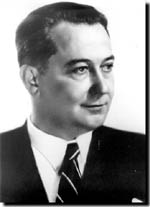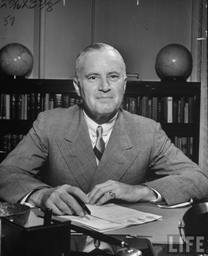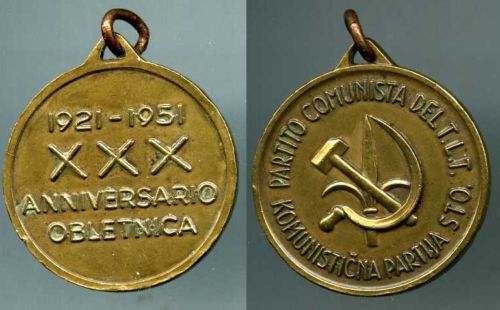1945 - 1947 (ZONE B) Yugoslavian Military Government
The military occupation of Yugoslavian troops must be divided in two periods between 1945 till 1947: from 1st May 1945 till 12th June 1945 in all Venezia Giulia and from 13th June 1945 till 1947 in the territory named ZONE B.
On 1st May Jugoslavian forces enter Trieste Area and take control of the city and many other zones of the rest of the Venezia Giulia.
On 5th May 1945 in Aidussina, the AVNOJ (yugoslavian CLN) decree the annexion of Trieste and Gorizia provinces, named Slovene Litoral, to the republic of Slovenija, as the III Region, as it results from the decrees n.1 and n.2 dated 12th and 24th May 1945 emitted by Regional President F. BEVK, that in the same occasion was elected Antifascist President of the Regional Council of Liberation of Slovene Litoral.

FRANCE BEVK
In Beograd on 9th June the United States, Great Britain and Jugoslavia agree a demarcation of occupation zones in the Venezia Giulia, along a demarcation line called Morgan (from the name of General William Morgan), that defines the divison of the territory in two zones. The western part, constituted by the area west side of the line Trieste-Caporetto-Tarvisio and the city of Pola, which is denominated ZONE A and given to the Allied Military Government (A.M.G.V.G.), the eastern part denominated ZONE B including Istria, Fiume the islands of Cherso and Lussino, are under the control of the Yugoslavian Military Administration. The agreement of Beograd enterd into force on 12th June 1945 when the Yugoslavian army left Trieste, Pola and Gorizia, but it is a momentary decision.
NOTE: The Anti-Fascist Council for the People's Liberation of Yugoslavia (ACPLY), known more commonly by its Yugoslav abbreviation AVNOJ, (SerboCroatian: Antifašističko Vijeće Narodnog Oslobođenja Jugoslavije, AVNOJ) was the political umbrella organization for the national liberation councils of the Yugoslav resistance against the World War II Axis occupation, eventually becoming the Yugoslav provisional wartime deliberative body. The AVNOJ was established on November 26, 1942 to administer terrorities under the Partisans' control. It was under the political leadership of the main resistance forces of Yugoslavia, during the Axis occupation of WWII.
Governo Militare Yugoslavo
L'occupazione militare yugoslava va divisa in due periodi tra il 1945 ed il 1947: dal Primo Maggio 1945 al 12 Giugno 1945 in tutta la Venezia Giulia e dal 13 Giugno 1945 al 1947 il territorio denominato ZONA B.
Le truppe yugoslave entrano a Trieste il primo Maggio e prendono il controllo della città e di molte altre zone della Venezia Giulia.
Il 5 maggio 1945 ad Aidussina, l'AVNOJ (il CLN Jugoslavo) delibera l'annessione delle province di Trieste e di Gorizia, col nome di Litorale Sloveno, alla Repubblica di Slovenia, quale III Regione, come risulta poi dai Decreti n° 1 e n° 2 del 12 e del 24 maggio del Presidente regionale F. Bevk, che nella stessa occasione viene eletto quale Presidente appunto del Consiglio Regionale Antifascista di Liberazione del Litorale Sloveno.
Il 9 giugno a Belgrado, Stati Uniti, Gran Bretagna e Jugoslavia, siglano un accordo che delimita le rispettive zone di occupazione all’interno della Venezia Giulia, lungo una linea di demarcazione definita Morgan (dal nome del generale William Morgan), che prevede la divisione del territorio in due zone. La parte occidentale, costituita dall’area ad ovest della linea Trieste-Caporetto-Tarvisio e dalla città di Pola, è denominata Zona A ed affidata al Governo Militare Alleato, mentre la parte orientale, denominata Zona B, comprendente l’Istria, Fiume e le isole di Cherso e Lussino, è posta sotto il controllo dell’amministrazione militare della Jugoslavia.
L’accordo di Belgrado, entrato ufficialmente in vigore il 12 giugno 1945, e cioè quando l’esercito jugoslavo abbandona Trieste, Pola e Gorizia, rappresenta però una sistemazione provvisoria.
NOTA: Il AConsiglio Anti-Fascista per la Liberazione del Popolo della Yugoslavia, era comunemente conosciuto con la sua sigla yugoslava AVNOJ, (SerboCroato: Antifašističko Vijeće Narodnog Oslobođenja Jugoslavije, AVNOJ) era l'organizzazione politica per i comitati di liberazione della resistenza yugoslava contro l'occupazione dell'Asse durante la Seconda Guerra Mondiale, divenendo il Comitato Esecutivo provvisorio in tempo di guerra della Yugoslavia. L' AVNOJ venne fondato il 26 Novembre 1942 per amministrare i territori controllati dai partigiani. Era sotto il controllo politico delle principali forze di resistenza in Yugoslavia durante l'occupazione dell'Asse.
Below you'll find videos, publications, informations and links regarding the period. They are ordered per date of publishing.
Sotto troverete filmati, pubblicazioni, informazioni e links riguardo al periodo. Sono ordinate per data di pubblicazione.
VENEZIA GIULIA
1st May - 12th June 1945
3.5.1945: I tedeschi ancora asserragliati nel castello di S.Giusto, nel palazzo di Giustizia e 2700 uomini a Villa Opicina, si arrendono ai neozelandesi. Gli Yugoslavi emettono i primi 2 ordini a Trieste :

5.5.1945: Gli Yugoslavi occupano Pola. Manifestazione di protesta a Trieste. Trieste risponde all'occupazione jugoslava con una manifestazione di popolo e cinque cittadini rimangono uccisi nel conflitto con gli slavi.
8.5.1945: Duro promemoria di Alexader a Tito.
9.5.1945: Il generale jugoslavo Dusan Kveder annuncia dal balcone del Municipio che Trieste è annessa definitivamente alla Jugoslavia.
TRST 1945 - rare reel regarding Yugoslavian speeches from Town Hall in a crowded Piazza in Trieste.
14h May 1945 - TIME (Click here or TIME Cover)
19.5.1945 Il maresciallo Alexander garantisce il mantenimento dei confini italiani per quanto riguarda Trieste e Gorizia Gli jugoslavi lasciano agli alleati la Carinzia austriaca e trovano il Governatore tedesco di Trieste Rainer.


4. Marshal Tito will withdraw the Yugoslav regular forces now in the portion of Venezia Giulia west of the line on the attached map as well as those in the town and vicinity of Pola by 08 hours GMT, June 12th 1945. Arrangements for the retention of the Yugoslav detachment referred to in paragraph 2 will be worked out between the Supreme Allied Commander and the Yugoslav High Command.
5. Any irregular forces in this area will, according to the decision of the Supreme Allied Commander in each case, either hand in their arms to the Allied Military authorities and disband, or withdraw from the area.
6. The Yugoslav Government will return residents of the area whom they have arrested or deported with the exception of persons who possessed Yugoslav nationality in 1939, and make restitution of property they have confiscated or removed.
7. This agreement in no way prejudices or affects the ultimate disposal of the parts of Venezia Giulia west of the line. Similarly the military occupation and administration by Yugoslavia of the parts of Venezia Giulia east of the line in no way prejudices or affects the ultimate disposal of that area.
Signed at Belgrade, June 9, 1945.
DR. IVAN SUBASIC - Minister of Foreign Affairs - [Yugoslavia]
R. C. SKRINE STEVENSON - H. B. M. Ambassador
RICHARD C. PATTERSON JR. - U.S. Ambassador
ACCORDO DI BELGRADO 9 Giugno '45
59 Stat. 1855 - Accordo esecutivo Serie 501
1. 1. - La parte del territorio della Venezia Giulia ad ovest della linea (ndr Morgan, vedi allegato) sulla mappa allegata che comprende Trieste, le ferrovie e le strade da lì in Austria via Gorizia, Caporetto e Tarvisio, così come Pola e gli ancoraggi sulla costa occidentale dell’Istria saranno sotto il comando e il controllo del comandante supremo delle forze alleate
2. 2. - Tutte le forze navali, militari e aeree ad ovest della linea sulla mappa allegata saranno poste sotto il suo comando dal momento in cui il presente accordo entrerà in vigore. Le forze jugoslave nella zona devono essere limitate ad un distacco di truppe regolari non superiori a 2000 di tutti i ranghi. Queste truppe saranno mantenute dal Comandante Supremo delle Forze Alleate dei servizi amministrativi. Essi occuperanno un quartiere scelto dal comandante supremo delle forze alleate a ovest della linea di demarcazione e non sarà consentito l'accesso al resto della zona.
3. 3. - Usando un governo militare alleato, il Comandante Supremo delle Forze Alleate amministrerà le zone ad ovest della linea sulla mappa allegata, Pola e le altre aree della costa occidentale dell’Istria come egli riterrà necessario. Una piccola missione iugoslava potrà essere distaccata alla sede della Ottava Armata in qualità di osservatori. Verrà utilizzata qualsiasi amministrazione civile jugoslava, già istituita, e che a parere del comandante supremo delle forze alleate stia lavorando in modo soddisfacente. Il governo militare alleato, tuttavia, potrà utilizzare le autorità civili che riterrà più adatte in qualsiasi luogo e a cambiare il personale amministrativo a sua discrezione.
4. 4. - Il maresciallo Tito ritirerà in parte le forze jugoslave regolari dalla Venezia Giulia ad ovest della linea sulla mappa allegata così come quelle in prossimità della città di Pola dalle 08 ore GMT, 12 giugno 1945. Disposizioni per il mantenimento del distacco iugoslavo di cui al paragrafo 2 saranno elaborate dal Comandante Supremo delle Forze Alleate e l'Alto Comando jugoslavo.
5. 5. - Tutte le forze irregolari in questo settore, secondo la decisione del comandante supremo delle forze alleate, consegneranno le armi in mano ai militari delle autorità alleate e si smobiliteranno, o si ritireranno dal settore.
6. 6. - Il governo jugoslavo permetterà il ritorno dei residenti della zona che hanno arrestato o deportato con l'eccezione delle persone che possedevano la cittadinanza jugoslava nel 1939, e la restituzione dei beni confiscati o che hanno rimosso.
7. 7. - Tale accordo non pregiudica o colpisce in alcun modo l'ultima disposizione sulle parti della Venezia Giulia ad ovest della linea. Allo stesso modo l'occupazione militare e l'amministrazione della Venezia Giulia da parte della Jugoslavia a est della linea non pregiudica o colpisce in alcun modo l'ultima disposizione per tale settore.
Firmato a Belgrado, 9 giugno 1945.
DR. Ivan SUBASIC - Il Ministro degli Affari Esteri - Jugoslavia
R.C. SKRINE STEVENSON - Ambasciatore HBM
Richard C. PATTERSON Jr. - Ambasciatore degli Stati Uniti
12.6.1945: Le truppe jugoslave lasciano Trieste.

Communist Party of the Free Territory of Trieste (in Italian: Partito Comunista del Territorio Libero di Trieste, PCTLT, in Slovenian: Komunistična partija Svobodnega tržaškega ozemlja, KPSTO) was a communist party in the Free Territory of Trieste. It was founded at a congress in 1945 by a merger of the local branches of the Italian Communist Party and the Communist party of Slovenia as the Communist Party of the Giulian Region (Partito Comunista della Regione Giulana, PCRG, Komunistična partija Julijske krajine, KPJK). The party published a daily newspaper, Il Lavoratore.
At the time of its foundation, the party favoured integration of the area with Yugoslavia. This stood in contrast with the line of the Italian Communist Party and its leader Palmiro Togliatti , which opposed Yugoslav claims to the region. The main leaders of the party were Rudi Ursic and the Yugoslav partisan leader Branko Babic.

BRANKO BABIC
In 1947, when the Free Territory was formally constituted, the party adopted the name PCTLT/KPSTO.
The party suffered a split following the June 28, 1948 resolution of Cominform, resulting in the expulsion of the Communist Party of Yugoslavia. The pro-Yugoslavia wing was led by Branko Babič, and the pro-Cominform wing was led by former Comintern agent Vittorio Vidali. The pro-Cominform wing was able to retain a majority in the Central Committee (6 against 4), and Vidali became the leader of the party. Under Vidali's leadership the party began opposing the annexation of the Free Territory by Yugoslavia.

VITTORIO VIDALI
The pro-Yugoslav minority was largely composed of Slovenian cadres. They formed a separate PCTLT under the leadership of Babič. The pro-Yugoslav minority then regrouped as the Italian Slovenian Popular Front (FPIS).
Although initially present in both the British-U.S.-controlled Zone A and the Yugoslavian-controlled Zone B, the PCTLT led by Vidali was suppressed in Zone B after the split. The FPIS took part in FTT elections in Zone A and continued to function after the integration of Zone A into Italy.
The PCTLT took part in the June 12, 1949 elections in the Free Territory. It obtained 35 568 votes (approximately 20% of the total vote), and 13 seats. In the same election, the pro-Yugoslav communists obtained one seat.
PCTLT was the sole pluriethnical political force in the Free Territory at the time, with a large following amongst both Italian and Slovenian workers. It ran a separate Slovenian-language organ, Delo.
The youth wing of the party was known as the Communist Youth Federation of the Free State of Trieste (Federazione Giovanile Comunista del Territorio Libero di Trieste). FGCTLT published Gioventù.
After the Zone A was integrated into Italy in 1954, the party merged into the Italian Communist Party (PCI) in 1957. Within the PCI, the Trieste communists had a Triestinian Autonomous Federation.
During that period many books were published and autonomy of the Party was evident. Here below you can see some pages of one of these books, click on the image:
Booklet: LO SVILUPPO ECONOMICO DI TRIESTE E LA QUESTIONE NAZIONALE - Vittorio Vidali (1953, Novembre)
V.U.J.A. - ZONE B - 1945 - 1947
18 ottobre 1945 - Nella zona B, viene adottata un'unità monetaria autonoma, la lira istriana (jugolira), creando una barriera economica con la zona A.

La lira triestina fu una valuta introdotta dal governatore militare jugoslavo, colonello Lenac , nella Zona B del Territorio Libero di Trieste. La valuta, introdotta in sostituzione forzata della lira italiana ebbe vita breve dal 18 ( o 29? ) ottobre 1945 fino al luglio 1949 quando l'uso del dinaro jugoslavo venne infine esteso anche in quest'area .
L'improvvisa introduzione di questa moneta, dispregiativamente chiamata "jugolira", generò panico e nella popolazione triestina e riducendo molte famiglie alla povertà e provocando una delle poche rivolte contro il governo della Zona B. Si trattò di uno sciopero dei negozianti di Capodistria/Koper, che si concluse con una azione di forza delle truppe jugoslave che prima ruppero le vetrine dei negozi, poi uccisero in una piazza due negozianti Angelo Zarli e Francesco Reichstein, danzando infine il Kolo attorno ai loro corpi.
Economicamente questa valuta non aveva potere d'acquisto al di fuori della zona B, ma venne resa obbligatoria la conversione da lire italiane a jugolire, con un cambio forzoso di 1:1, delle valute in lira italiana portate da chi provenendo dalla zona A entrava nella zona B triestina, permettendo in tal modo la raccolta, da parte delle autorità jugoslave di valuta relativamente pregiata.








